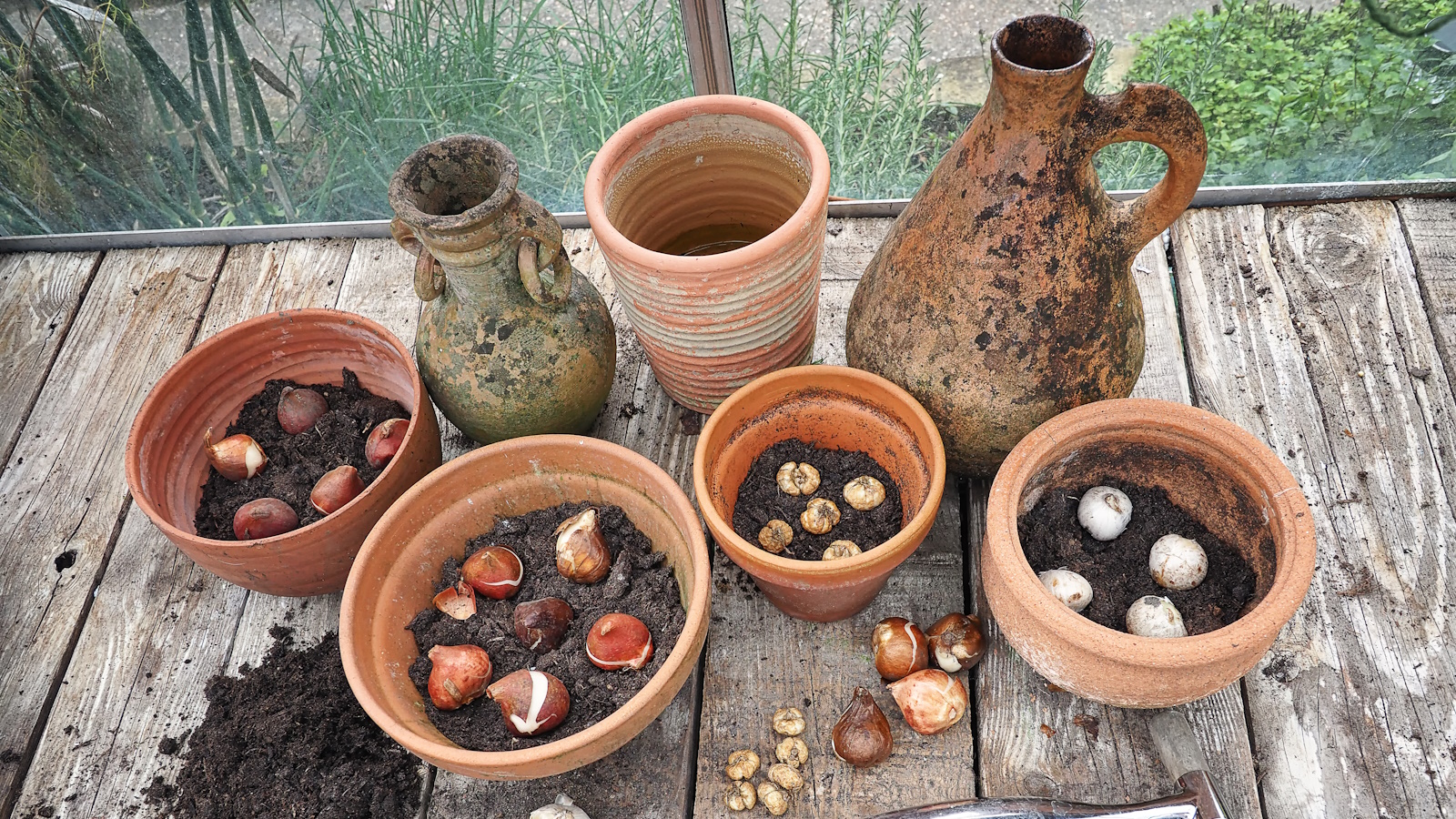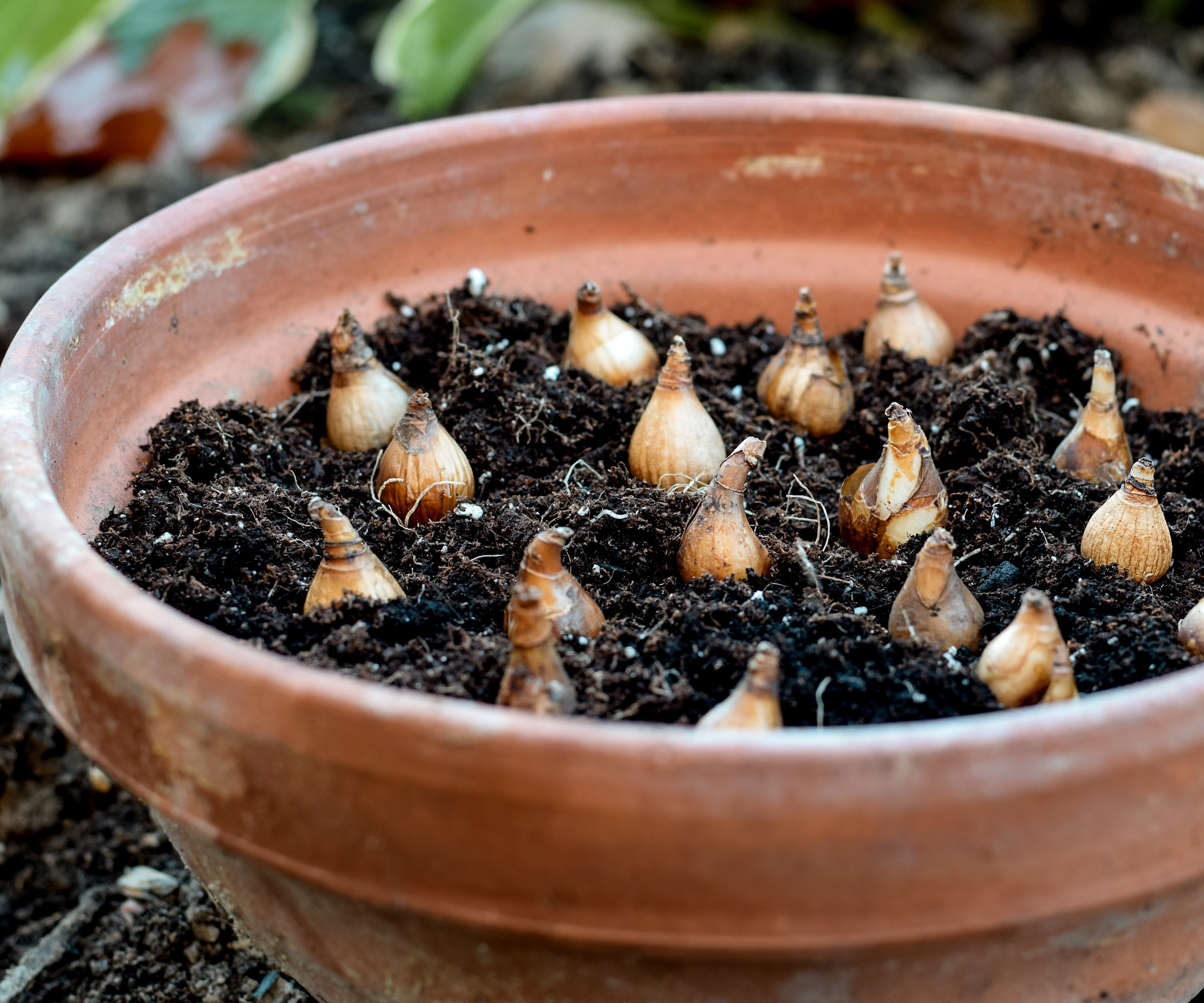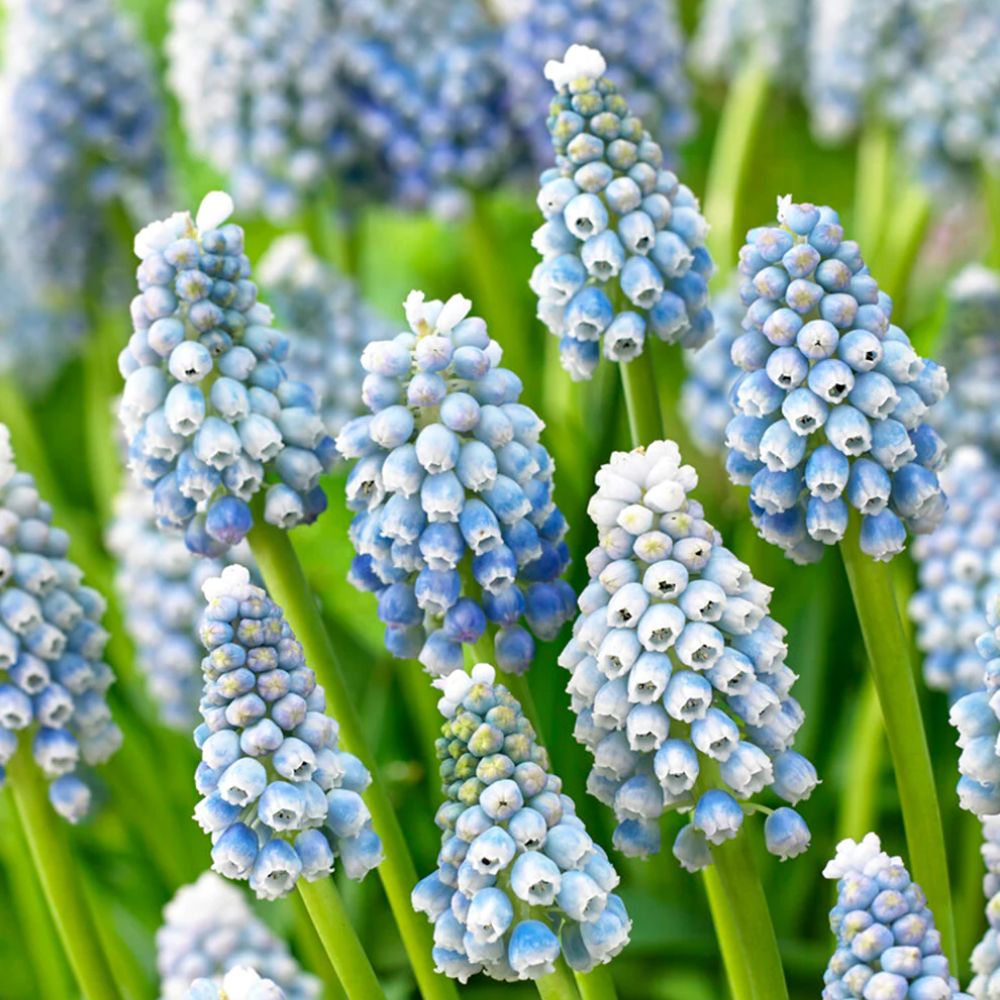How to create a bulb lasagna in a container – for wave after wave of springtime blooms
Learn how to layer bulbs for a continuous display of color, from winter’s end to late spring


There’s no better way to guarantee a colorful, long-lasting display of spring flowers than by planting a bulb lasagna this fall. This clever method, championed by gardening legend Monty Don, involves layering different types of bulbs in a container to stagger their blooming, providing you with waves of vibrant blooms from early spring through to late May.
By planting spring bulbs in October or November, you can set the stage for a stunning display next year. The key to maintaining continuous color is choosing bulbs that bloom at different times, ensuring your flowers don't all peak at once.
Now is the perfect time to plan this simple project. We’ve asked gardening experts to share their top tips for creating a bulb lasagna – from selecting the right supplies to picking the ideal mix of bulbs.
Creating a bulb lasagna in a container
The concept behind a bulb lasagna is simple. You arrange the bulbs according to their blooming times, with the largest and latest-flowering bulbs at the bottom, and the smallest, earliest bloomers on top. Monty Don recently showcased this technique on his Instagram, illustrating how each layer of your ‘lasagna’ will eventually bloom in succession:
A post shared by Monty Don (@themontydon)
A photo posted by on
This technique is particularly effective in small backyards, patios, and balcony gardens where space is limited, allowing you to pack plenty of vibrant color into a compact area.
What you will need
This project is relatively straightforward, so you will likely have most of the kit to hand already:
- A large, deep pot – Aim for a container that is at least 12-16 inches deep to allow space for multiple layers of bulbs.
- High-quality compost – Monty Don suggests a mix of compost, perlite or grit for free drainage. Adding leaf mold can give your bulbs an extra boost.
- A variety of bulbs (see below)
- Gardening gloves
- A trowel for planting
What are the best spring bulbs to use?
Choosing the right combination of bulbs is the secret to ensuring your display continues to flourish throughout spring. We took some tips from Monty Don on BBC's Gardeners' World and asked Lydia Beaumont, gardening writer for Gardeners Yards, and Tammy Sons, Owner and CEO of TN Nursery, for their top suggestions.
Design expertise in your inbox – from inspiring decorating ideas and beautiful celebrity homes to practical gardening advice and shopping round-ups.
The bottom layer (late bloomers)
This layer consists of the largest bulbs, which will bloom later in spring. These will provide the final, show-stopping flourish in your container, so don’t be afraid to go for some high-impact bulbs or unique varieties.
Tulips (April-May): Tulips are Monty Don’s top choice for the bottom layer, as these classic spring plants will add height and a little drama to your display. Monty suggests looking for large, plump bulbs for the best blooms (he uses Tulip Negrita, known for its tall stems and rich purple flowers). Other popular varieties include Tulip Queen of Night, featuring deep maroon petals, and Tulip Ballerina, with its elegant orange flowers.
Alliums (May-June): Lydia Beaumont suggests using alliums for your bottom layer, as these bulbs will lend a striking architectural quality to your container, with their globe-shaped flowers and tall, robust stems. Some of the best varieties of allium include Allium Purple Sensation or Allium Christophii.

Lydia Beaumont is a gardening expert who is passionate about creating beautiful, liveable spaces. Whether crafting stylish table settings or transforming a garden into a personal oasis, Lydia loves making every space stunning and comfortable.
Middle layer (mid-season bloomers)
These bulbs will bloom in mid-spring, providing a stunning burst of color as the early bloomers begin to fade.
Daffodils (March-April): It wouldn’t be spring without daffodils. These cheerful flowers are a must for brightening up any bulb lasagna. Narcissus Tete-a-Tete is a dwarf variety perfect for pots. Other great choices include Narcissus Thalia, with its pure white, fragrant blooms, or Narcissus Cheerfulness, which produces soft yellow, double flowers.
Hyacinths (March-April): Hyacinths not only add vibrant color to containers but they also fill the air with their sweet fragrance. Consider varieties like Hyacinth Delft Blue (classic blue) or Hyacinth Pink Pearl (bright pink) for a powerful sensory experience.
Top layer (early bloomers)
The top layer should feature small bulbs that flower in early spring, kicking off your display with a splash of color as winter fades.
Crocus (February-March): 'Other than daffodils, crocuses are usually the second plant to bloom in early spring, and sometimes snow sits on them because they start blooming so early,' says Tammy Sons, CEO of TN Nursery. This makes them idea for the top layer of your bulb lasagna. Varieties like Crocus Jeanne d’Arc (white), Crocus Ruby Giant (purple), and Crocus Yellow Mammoth (bright yellow) will create a vibrant early display.
Dwarf Iris (February-March): These tiny irises, such as Iris reticulata in varieties like Pixie or Harmony (intense blue-purple), bloom in late winter or early spring and provide jewel-like color in your container.
Muscari (April-May): Also known as grape hyacinths, Muscari armeniacum produces small, grape-like clusters of blue flowers that bring a fresh pop of color in mid-spring.

Tammy Sons is the Founder and CEO of TN Nursery. With decades of experience in horticulture, she specializes in native plants and sustainable gardening practices, making her an excellent resource for selecting bulbs.
How to plant a bulb lasagna

- Prepare your pot: Begin by covering the drainage hole with a piece of broken terracotta to stop compost from escaping. Fill the pot with a layer of compost, mixed with grit or perlite for good drainage.
- Plant the bottom layer: Start with your largest bulbs. Monty Don suggests planting tulips, spacing them 1-2 inches apart, pointy side up. The larger the bulb, the better they’ll flower, so aim for plump bulbs for the best results. Cover with a layer of compost.
- Add the middle layer: Next, plant mid-season bloomers like daffodils. These bulbs should be planted 4-6 inches above the tulips. Don’t worry about the roots – they’ll find their way around the bulbs beneath them.
- Plant the top layer: Finally, add your smallest, earliest bloomers such as dwarf irises or crocus, around 2-3 inches deep. These will flower first, creating the start of your display.
- Top with seasonal bedding (optional): For an extra splash of winter color before your bulbs begin to flower, you can add pansies or violas to the surface of the container. Monty suggests watering these regularly to keep them healthy. The bulbs will push through as the flowers die back.
- Position your container: Place your bulb lasagna in a sunny, sheltered spot and water thoroughly. As the bulbs start to shoot in the spring, move the pot to a prominent position where you can enjoy the emerging display.
Add winter bedding flowers

Before your first bulbs bloom, your bulb lasagna may look a bit bare. To give it a finishing touch, you could add a layer of winter bedding plants on top. This will provide a colorful interim display and keep your container visually interesting throughout the colder months.
Pansies: Pansies are a classic choice for adding color to containers in the colder months. Available in a wide variety of shades, from deep purples to sunny yellows, the best winter pansies will bloom through the winter and into early spring. They will also allow the other bulbs to push through as they grow, without hindering their progress.
Violas: Violas are similar to pansies but with smaller flowers. They’re hardy and will thrive in cool conditions, bringing continuous color to your pot. Viola Sorbet and Viola Johnny Jump Up are popular choices, offering rich shades of purple, yellow, and white.
Cyclamen: Hardy Cyclamen, with its delicate, nodding blooms and attractive heart-shaped leaves, will add lovely texture to your pot. Cyclamen will also continue to provide color and interest as your first layer of bulbs begin to push through.
You can also plant a bulb lasagna directly into the ground in USDA hardiness zones 3 to 8. Dig a hole at least 12 inches deep, layer bulbs from largest to smallest, and cover each layer with soil.

Gabriella is a freelance contributor for Homes & Gardens. She is a DIY enthusiast and a lover of all things interior design, often found antiquing or browsing the aisles of her local hardware store. She has a particular passion for historic buildings and is in the process of renovating a Victorian coachhouse in the countryside.
For much of the past decade, Gabriella has worked as a freelance writer, crafting copy for national publications and renowned homeware brands. Most recently, she worked for Homebuilding & Renovating Magazine and is the former Head of Solved at Homes & Gardens, focusing on case studies for the magazine and website, as well as writing features about issues surrounding historic and listed building projects.











